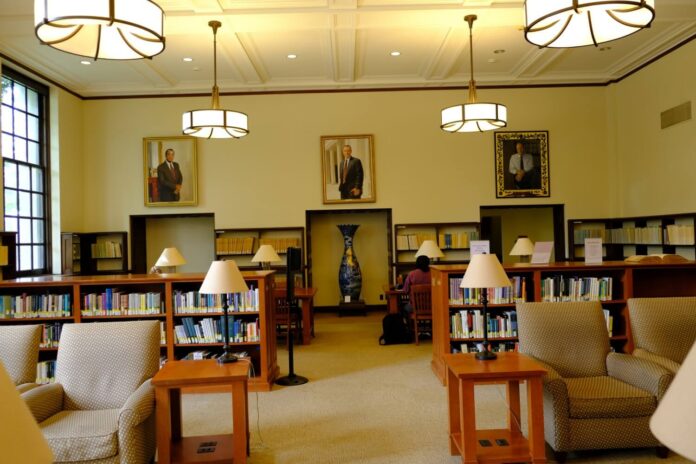
Shortly after the 2007 opening of the Ahmanson Reading Room in the Mary Norton Clapp Library, the portraits of six former Occidental presidents have watched over students and the remaining book collection. As the six were previously displayed in the Cushman Boardroom in the Arthur G. Coons (AGC) building, a smaller-scale collection of seven separate former presidents replaced them, which remain in the Special Collections and College Archives vault as of 2012 due to AGC renovations.
Special Collections Instructor Research Librarian Helena de Lemos has been working at Occidental for 17 years, commencing with her inventory of artworks held by the college as an intern. She said she keeps track of pieces, including the six presidential portraits in the Ahmanson Reading Room and the seven painted portraits in the Special Collections vault. The portraits represent 13 of Occidental’s 16 previous presidents.
“What’s on display, what’s not on display, it’s not any kind of censorship. It’s usually the logistics of it, like safety concerns, where it goes, who keeps an eye on it,” De Lemos said. “Usually, what gets displayed or not, it’s mostly down to us being short-staffed; who’s really going to be in charge of it.”
In the vault collection, former President Rev. Samuel Weller (1887-1891), J. Melville McPherron (1891-1894), Rev. Elbert Condit (1894-1896), Rev. James Parkhill (1896-1897), Rev. Guy Wadsworth (1897-1905), Rev. William Young (1905-1906) and Thomas Burt (1916-1917) remain. According to De Lemos, these portraits may have been done after the presidents’ terms from photographs. All oil on canvas portraits in the vault were done by W.V. Brace in the 20th century, she said.
“They could be displayed again,” De Lemos said. “I think it’d be a good idea.”
According to De Lemos, Occidental holds other portraits of notable figures, including a 1955 painted portrait of the United States Chief Justice Earl Warren in what is now the LA Reading Room, which was donated to the college.
“We have set up a new committee here in the library for exhibits to really look at our art collection and try to get more things displayed, and try to come up with plans about that,” she said. “If students have requests for things they would like to see, and [we will] reach out to the community as well.”
Of those displayed in the Ahmanson Room are former presidents John Baer (1906-1916), Rev. Remsen Bird (1921-1946), Arthur Coons (1946-1965), John Brooks Slaughter (1988-1999), Theodore Mitchell (1999-2005) and Jonathan Veitch (2009-2020). Bulgarian-born artist Ross Rossin painted both Slaughter and Mitchell’s portraits in 2006 from photographs he took while on campus in Fall 2005.
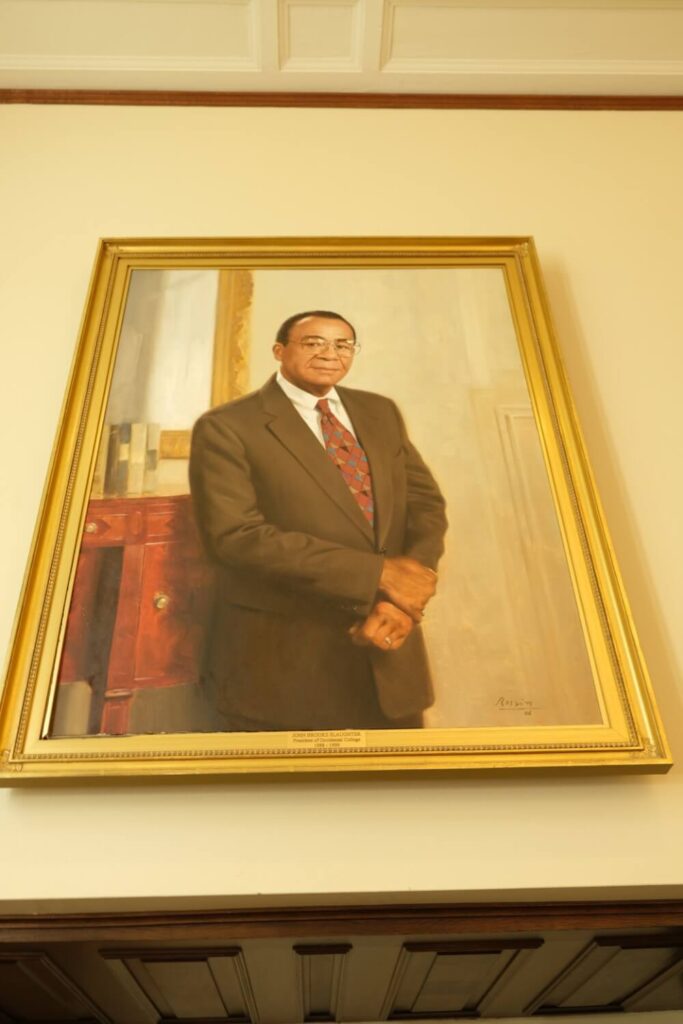
“The paintings are never really a copy of an existing picture, it’s a compilation. I’m trying to express much more than just the likeness,” Rossin said. “My impression of the person, the personality, is much more important than the likeness.”
After spending the past 54 years of his life mastering his craft, Rossin said portraits such as these typically take him a week to complete. Rossin has completed over 800 painted portraits and sculptures, having figures such as Maya Angelou and Morgan Freeman sit for him. According to Rossin, his process includes a short conversation with the honoree, even if working from a photograph, to capture their personality by observing the way they conduct themselves.
“I can produce a work of art that can convey certain energy, and that energy lasts for quite a while,” Rossin said. “The paintings last for centuries, they carry this energy and message of the person for generations to come.”
According to Rossin, he typically views previous portraits when visiting the institution or corporation. He said he intends for his work to fit well within the collection in terms of size and feel, and to generally have a feeling of continuous style.
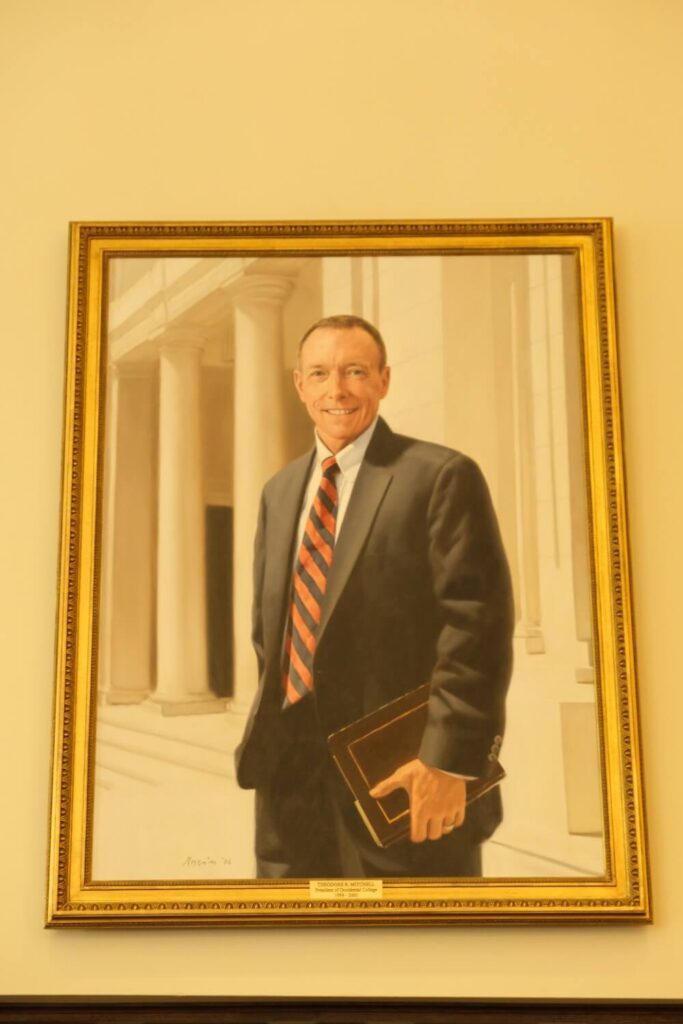
While the portrait style of Mitchell and his predecessors echo each other, one portrait with a gilded frame and floral accents breaks the trend. Connecticut artist Kathy Coe depicted Veitch surrounded by painted oak leaves and inscriptions. Coe said she worked closely with Veitch, who said he sat for about 10 hours for the painting.
“We tried to keep it a similar size as the other ones, the one difference that we both agreed on was to do something that would tell the story of his time as president to help people get to know him more,” Coe said. “In traditional portraits, usually you don’t really know the person unless you were going to school at that time. It was important in telling the story of his time as president.”
Within the border lie myriad details related to Veitch’s personal life and the college. In the top right corner, Veitch’s Fiat hides behind an oak leaf and further below, his “Son of a Veitch” hot chocolate recipe in small lettering. Birds represent his work renovating the Moore Laboratory of Zoology during his presidency, and Occidental squirrels sit atop the branches. The top script of Magdalena’s Lamp comes from his 2009 Inaugural address, where he discussed the lamp of learning and a story of a past Occidental student, while the bottom script discusses an oak tree and cherry blossoms.
“The theme of the cherry blossoms is that there may be kind of seasonal things one can do, like cherry blossoms falling,” Veitch said. “But what really matters is kind of carrying the institution of the long term, kind of the strength and the longevity of an oak as opposed to the ephemeral nature of cherry blossom.”
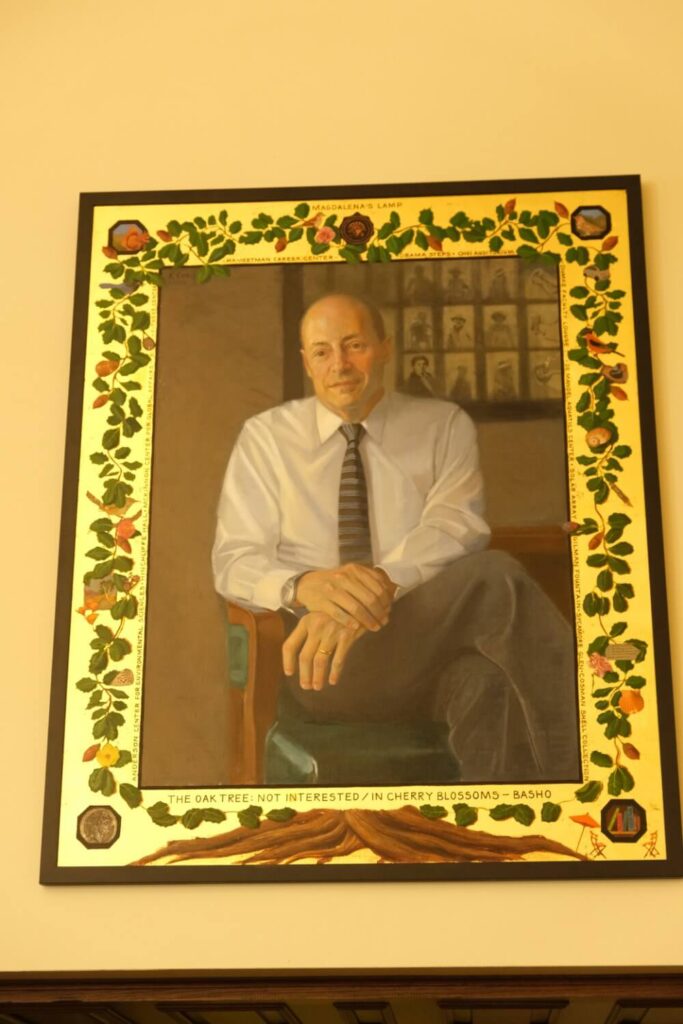
Coe said she loved the details featured in the piece, particularly the nature motifs, the miniature umbrella with orange chairs and the story of Magdalena’s lamp. She said that she was able to attend the unveiling ceremony at Sycamore Glenn in 2022, which was delayed due to COVID-19, though she could have worked on the piece for a long time afterward with the amount of lively details.
“For me, it was a real dream project. I was so excited by it and to work with Jonathan, he’s so smart and imaginative and thoughtful,” Coe said. “It was a very enriching experience.”
Veitch said he doesn’t tell his students about his former presidency, but about two-thirds of the way through the semester, he said a student sitting in the room will put two and two together. According to Veitch, his portrait plays a role in telling a continuous history at Occidental, though he recognizes that it is also an anachronistic form.
Art & Art History professor Samuel Luterbacher said that the tradition of portraiture reappeared in the 16th century to capture the elite of society, particularly monarchs, kings and queens of Europe. To this day, he said, newly anointed citizens of the UK must swear allegiance in front of a painted portrait of the monarch. According to Luterbacher, the United States’ history in British colonialism and postcolonialism plays a role in the tradition of portraiture, and even though it is now a democratic system, the first portraits of the president are extremely important.
“[Painted portraiture] is something that continues today because it’s rooted in ways in which power in America has been represented,” Luterbacher said.
As a medium, Luterbacher said that painting has a material fabric that seems to come from the past and descends as an avenue to represent identity, especially via physiognomic resemblance in the Western framework.
“It’s your face that stands as something that identifies you. Of course, that has a lot of problematic elements — racial bias, racial categorization — built into those elements,” Luterbacher said. “The portrait is bound to a kind of categorization of human beings that appeared within the 16th century through colonization and imperialism.”
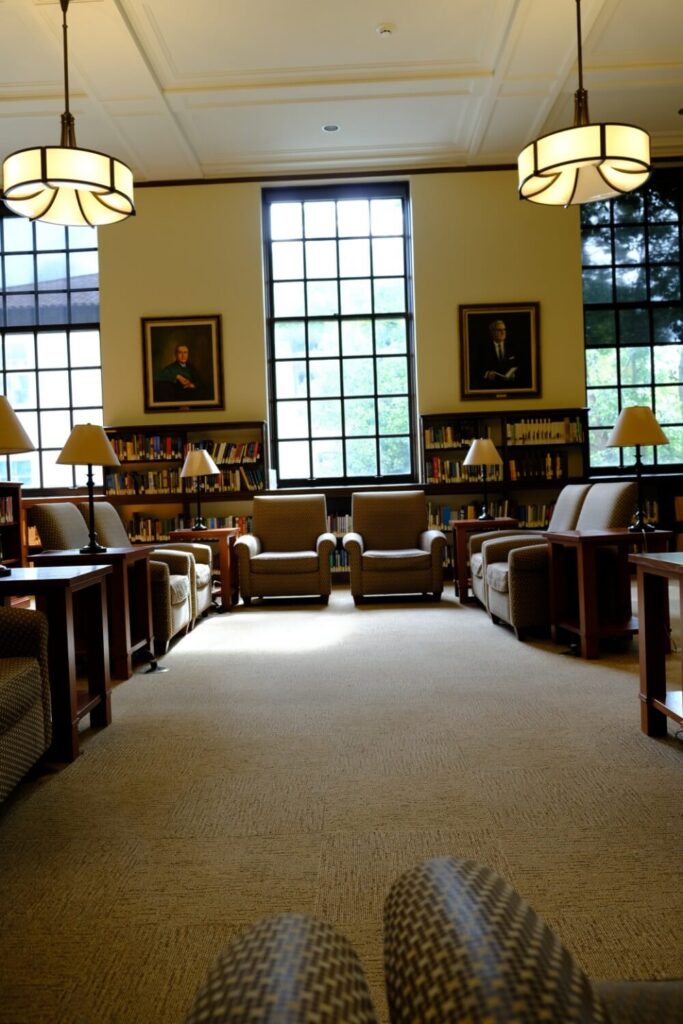
Within institutions like Occidental, he said the portraits may play a role in maintaining institutional legitimacy by constructing a certain idea of the past and power.
“Of course, we have presidential portraits, and of course, they’re painted,” Luterbacher said. “But then when we look at the deeper history of it, it overlays it and gives us the possibility for students and the Oxy community to think, ‘Maybe we could do something different, or could we rethink it in some ways?’ How do we portray the legacy and identity of someone? Maybe not through traditional modes of representation.”
As for the future of the presidential portraits, De Lemos and Vice President for Marketing & Communications Rod Leveque said President Harry Elam will be recognized in a painted portrait. The portrait is currently in the works, according to De Lemos.
While Elam said he has never sat for a portrait before, he expected the artist to work from a photograph, as Rossin did.
“I feel particularly honored to be included in this group of presidents. I wish I could have been here longer, but it’s been very special and incredible being a part of the Occidental community,” Elam said. “I am deeply touched to be memorialized in this way.”
According to Elam, he would like his portrait to include a reference to the poem “Dreams” by Langston Hughes, as it reflects a sense of vision towards the future for Occidental to become.
“We all have to hold on to our dreams,” Elam said. “The poem speaks to me personally, as well as the thoughts and vision for the future of the college.”
While portraiture is a longstanding tradition in art history, Veitch said its place at Occidental speaks to the language of stability and continuity colleges and universities as institutions have, despite their conflict and controversy.
“It’s nice to be there among my predecessors and to make room for my successors,” Veitch said. “It charms me, and it still matters to me.”
Contact Mollie Barnes at mbarnes@oxy.edu
![]()


































